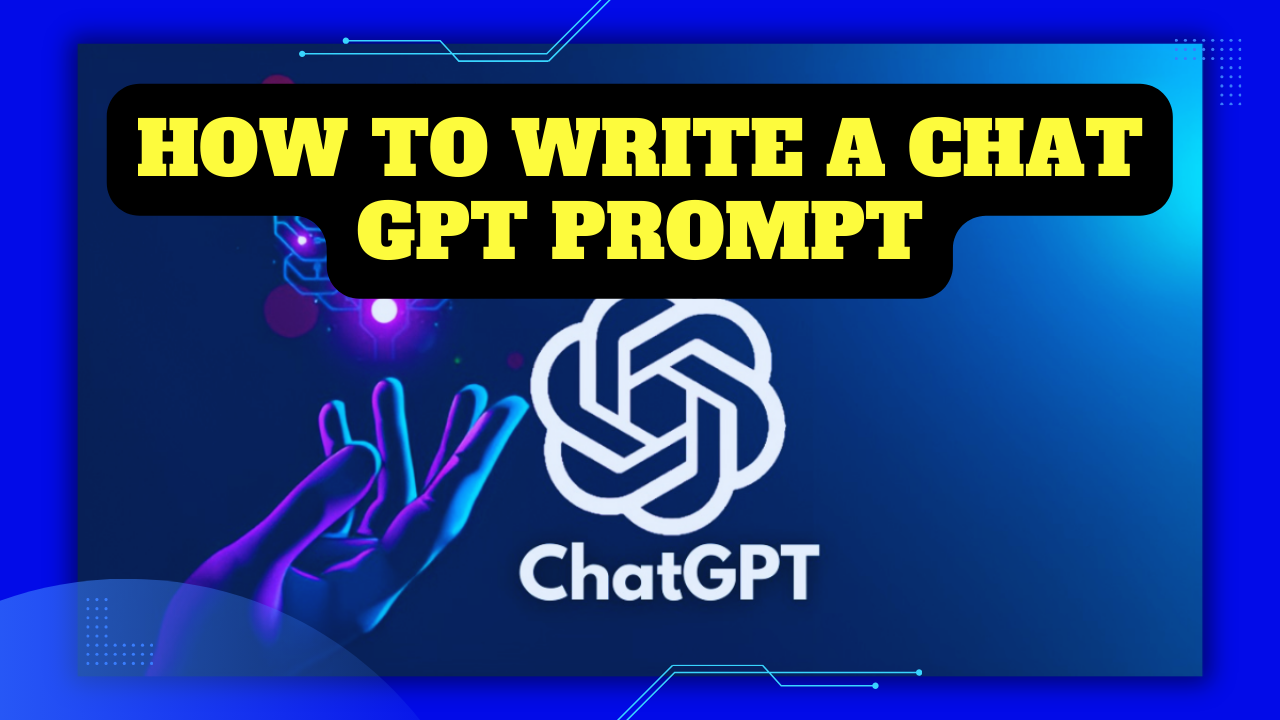Introduction: How to Write a Chat GPT Prompt
In the realm of AI-powered chatbots and virtual assistants, the ability to craft effective prompts is the key to unlocking their potential. Whether you're using Chat GPT for content generation, customer support, or simply engaging in a creative conversation, knowing how to write a Chat GPT prompt can make all the difference. This comprehensive guide will walk you through the art and science of crafting prompts that yield meaningful and accurate responses.
Section 1: Understanding Chat GPT Prompts
1.1 What is a Chat GPT Prompt?
Before we dive into the intricacies of prompt writing, let's define what a Chat GPT prompt is. In the context of AI like OpenAI's GPT models, a prompt is a user's input or instruction that initiates a conversation or elicits a response from the AI. It serves as the starting point for the AI's generation of text-based replies.
1.2 The Importance of Well-Crafted Prompts
The quality of a Chat GPT prompt plays a pivotal role in the quality of the AI's response. Well-crafted prompts can:
Enhance Clarity: Clear and specific prompts lead to more precise responses.
Guide Tone and Style: The way you phrase your prompt influences the tone and style of the AI's response.
Set Objectives: A prompt should convey the desired outcome or information you seek.
Prevent Misunderstandings: Crafting prompts with care reduces the risk of the AI misinterpreting your intent.
A well-crafted prompt is the foundation upon which you build a productive AI interaction.
Section 2: Crafting Effective Chat GPT Prompts
2.1 Defining Your Objective
The first step in prompt creation is to define your objective. Ask yourself, "What do I want to achieve with this interaction?" Whether it's getting information, generating creative content, or providing assistance, a clear objective informs your prompt.
2.2 Clarity and Specificity
Clarity is paramount. Ensure your prompts are concise, unambiguous, and to the point. Avoid vague language that might confuse the AI. Specificity helps, too. Instead of "Tell me about dogs," consider "Provide a brief history of Labrador Retrievers."
2.3 Tone and Style
Consider the tone and style you want in the AI's response. Are you aiming for a formal tone, a casual chat, or a creative storytelling style? Your prompt should reflect this.
2.4 Length and Structure
Keep your prompts concise, but provide enough context for the AI to understand your request. Long, convoluted prompts may lead to misunderstandings. Use proper sentence structure and punctuation for clarity.
Section 3: Leveraging Chat GPT Prompt Templates
3.1 Introduction to Prompt Templates
When it comes to efficiency and consistency in prompt creation, leveraging templates is a game-changer. Prompt templates are predefined structures or formats that guide you in framing your prompts effectively. They offer a structured approach that saves time and ensures your prompts align with your goals.
Common Types of Prompt Templates:
Question Templates: These templates are designed for eliciting informative responses. Example: "Can you explain the process of photosynthesis?"
Instruction Templates: Use these to provide clear instructions to the AI. Example: "Write a summary of the book 'To Kill a Mockingbird.'"
Storytelling Templates: Ideal for generating creative content or storytelling prompts. Example: "Create a short story about an astronaut stranded on Mars."
Comparison Templates: These prompts help in drawing comparisons or contrasts. Example: "Compare and contrast the pros and cons of electric cars and traditional gasoline cars."
3.2 Building Custom Prompt Templates
While predefined templates are handy, custom templates tailored to your specific needs can be even more powerful. Here's how to create them:
Identify Your Common Use Cases: Analyze your typical use cases for AI interactions. Are you often seeking information, generating content, or engaging in creative conversations? Define these scenarios.
Structure Your Templates: Design templates that suit your use cases. For instance, if you frequently ask for product descriptions, create a template for that. Ensure they incorporate clarity, specificity, and your preferred tone.
Test and Refine: Test your custom templates with the AI to ensure they generate the desired responses. If necessary, iterate and refine them based on the AI's performance.
Store and Organize: Maintain a library of your custom templates for easy access. Organize them by use case or category to streamline prompt creation.
By harnessing the power of prompt templates, you can consistently produce prompts that yield high-quality AI responses while saving time in the process.
Section 4: Testing and Iterating Your Prompts
4.1 The Importance of Testing
Once you've crafted your Chat GPT prompts, the next crucial step is testing. Testing serves several purposes:
Accuracy Assessment: It helps you evaluate the accuracy and relevance of AI responses to your prompts.
Fine-Tuning: Through testing, you can identify areas where the AI might misinterpret or provide suboptimal responses.
Objective Alignment: Ensures that the AI's responses align with your intended objectives.
Refinement: Testing reveals any potential issues or ambiguities in your prompts that need refinement.
4.2 Collecting and Analyzing Responses
To test your prompts effectively, follow these steps:
Create a Testing Environment: Use a dedicated environment or platform where you can interact with the AI safely.
Pose Questions and Review Responses: Pose a variety of questions or prompts to the AI based on your objectives. Record the responses generated by the AI.
Analyze Response Quality: Assess the quality of responses. Look for accuracy, relevance, and alignment with your goals. Pay attention to any instances where the AI may provide biased or inappropriate content.
4.3 Refining Your Prompts
After testing, it's time to refine your prompts based on the insights gained:
Address Ambiguities: If the AI consistently misinterprets certain phrases or instructions, clarify your prompts to eliminate ambiguity.
Fine-Tune Objectives: If responses are not meeting your objectives, adjust the objectives and prompts accordingly.
Eliminate Bias: Ensure your prompts avoid leading questions or biased language that might result in biased responses.
Optimize Clarity: Make prompts more concise and specific to enhance response quality.
Testing and refining your prompts is an iterative process. It may take several rounds of testing and adjustment to achieve the desired outcomes. Remember that as AI models evolve, periodic testing and refinement are essential to keep your prompts effective.
In the next section, we'll delve into ethical considerations in prompt writing and how to ensure responsible AI use.
Section 5: Ethical Considerations in Prompt Writing
5.1 Ensuring Responsible AI Use
Ethical considerations play a pivotal role in chat GPT prompt writing. Here are steps to ensure responsible AI use:
Transparency:
Disclosure: Clearly state when the interaction involves AI to set user expectations.
AI Identity: If the AI has a name or persona, make it clear that it's artificial.
Bias Mitigation:
Bias Review: Regularly review prompts and responses to identify and rectify biases.
Avoid Stereotyping: Steer clear of prompts that reinforce stereotypes or prejudices.
5.2 Avoiding Bias and Harmful Content
Fairness and Equity:
Inclusive Language: Use inclusive and non-discriminatory language in prompts.
Avoid Controversial Topics: Be cautious when creating prompts related to sensitive or controversial subjects.
Content Moderation:
Filter Harmful Content: Implement filters to prevent AI from generating harmful or inappropriate content.
Human Oversight: Have human moderators review AI-generated responses, especially in critical applications.
5.3 Regular Audits
Periodically audit your prompts and AI interactions to ensure they comply with ethical standards. As AI evolves, staying vigilant and proactive in addressing ethical concerns is paramount.
In the next section, we'll explore real-world applications of chat GPT prompts and how they can benefit various domains.
Section 6: Real-World Applications of Chat GPT Prompts
Chat GPT prompts have found applications in various domains. Let's explore how they are utilized in the real world.
6.1 Content Generation
One of the prominent applications of Chat GPT prompts is content generation. Content creators and marketers can use AI-generated prompts to:
Generate Blog Ideas: AI can suggest topics and even outline blog posts based on specific keywords or themes.
Social Media Posts: Create engaging social media captions and posts with the help of AI-generated prompts.
Product Descriptions: Generate product descriptions for e-commerce websites efficiently.
6.2 Customer Support Chatbots
Chatbots are widely used in customer support. Chat GPT prompts enhance their effectiveness by:
Answering Queries: Chatbots can provide detailed responses to customer queries by utilizing well-structured prompts.
Troubleshooting: Walk customers through troubleshooting steps with clear and concise prompts.
Information Retrieval: Access and provide information from knowledge bases using AI-generated prompts.
6.3 Virtual Assistants
Virtual assistants like Siri and Alexa leverage Chat GPT prompts for improved interactions. In this context:
Voice Commands: Users can interact with virtual assistants more naturally using prompts for voice commands.
Information Retrieval: Virtual assistants can answer general knowledge questions with the help of AI-generated prompts.
Task Automation: Virtual assistants can execute tasks based on user prompts, such as setting reminders or sending messages.
These real-world applications highlight the versatility and practicality of Chat GPT prompts across various industries and domains.
Section 7: Tools and Resources for Prompt Creation
Creating effective Chat GPT prompts can be facilitated by using various tools and resources. Here are some that can aid you in the prompt creation process:
7.1 AI Platforms
OpenAI's GPT-3 Playground: An interactive platform for experimenting with GPT-3 prompts and responses. It offers a user-friendly interface for testing prompts.
ChatGPT: OpenAI's chat-based language model that can assist in generating chatbot prompts and conversations.
7.2 Prompt Testing Tools
PromptDuel: A tool for A/B testing different prompts and measuring their effectiveness in generating desired responses.
Prompt Analysis Tools: These tools can analyze the quality and potential bias in your prompts and AI responses.
7.3 Conversation Design Platforms
Dialogflow: Google's natural language understanding platform for designing and integrating conversational experiences across multiple platforms.
Microsoft Bot Framework: A framework for building chatbots and virtual assistants with extensive design capabilities.
Rasa: An open-source conversational AI platform for designing chatbots and assistants with advanced features.
These tools and platforms can simplify the process of creating, testing, and refining your Chat GPT prompts. They offer a range of features to enhance prompt effectiveness and user experience.
Section 8: Common Pitfalls to Avoid in Chat GPT Prompts
Crafting effective Chat GPT prompts is essential, but there are common pitfalls that you should be aware of and avoid:
8.1 Lack of Clarity
Pitfall: Using vague or ambiguous language in prompts can lead to responses that miss the mark.
Solution: Be precise and clear in your prompts. State your expectations explicitly to get the desired responses.
8.2 Unintended Bias
Pitfall: Unconscious bias in prompts can result in biased responses that may perpetuate stereotypes or discrimination.
Solution: Regularly review prompts for bias. Use inclusive language and avoid controversial or sensitive topics.
8.3 Overly Complex Prompts
Pitfall: Prompts that are too complex or convoluted can confuse the AI model and lead to inaccurate responses.
Solution: Keep prompts straightforward and concise. Break down complex queries into simpler, more digestible prompts.
Avoiding these pitfalls is crucial for getting the most out of your Chat GPT interactions. In the concluding section, we'll summarize the key takeaways from this guide.
Conclusion: How to Write a Chat GPT Prompt
In this comprehensive guide, we've delved into the art and science of writing effective Chat GPT prompts. Crafting prompts that yield valuable and contextually appropriate responses is essential for harnessing the power of AI-driven conversations.
Here are the key takeaways:
Understand Chat GPT Prompts: Begin by grasping what Chat GPT prompts are and their significance in AI interactions.
Crafting Effective Prompts: Explore the intricacies of creating prompts, including defining objectives, ensuring clarity, setting the right tone, and considering length and structure.
Leverage Prompt Templates: Discover how prompt templates can simplify and standardize your prompt creation process.
Testing and Iteration: Learn the importance of testing prompts, collecting responses, and refining prompts based on feedback.
Ethical Considerations: Embrace ethical practices in prompt writing, ensuring responsible AI use and avoiding bias and harmful content.
Real-World Applications: Explore the diverse applications of Chat GPT prompts, from content generation to customer support and virtual assistants.
Tools and Resources: Familiarize yourself with valuable tools and platforms for prompt creation and testing.
Common Pitfalls: Be aware of common pitfalls like lack of clarity, unintended bias, and overly complex prompts, and how to avoid them.
With this knowledge, you're well-equipped to navigate the world of Chat GPT prompts and harness the potential of AI-driven conversations for various purposes.
As you embark on your journey of prompt writing, remember that practice and continuous improvement are key. AI technology evolves, and your ability to craft effective prompts will evolve with it.
FAQ: How to Write a Chat GPT Prompt
Q1: Can I use the same prompts for different AI models?
A1: While some prompts may be adaptable, it's essential to tailor your prompts to the specific AI model you're using. Different models have unique capabilities and requirements.
Q2: How can I avoid my prompts becoming too repetitive?
A2: Variety is key. Experiment with different phrasings, tones, and styles in your prompts. Additionally, periodically update your prompt templates to keep the interactions fresh.
Q3: What should I do if I receive biased responses from AI?
A3: Review your prompts for potential biases. Adjust them to be more neutral and inclusive. If biases persist, consider contacting the AI provider for guidance.
Q4: Are there any regulations for AI prompt content?
A4: Depending on your use case and location, there may be regulations governing AI-generated content. It's crucial to stay informed about relevant laws and guidelines.
Q5: Can AI-generated content be copyrighted?
A5: Copyright laws can be complex, and the attribution of AI-generated content is a topic of ongoing discussion. Consult with legal experts to understand the copyright implications in your specific context.
Q6: How can I measure the effectiveness of my prompts?
A6: Use metrics such as response relevance, user satisfaction, and task completion to assess prompt effectiveness. A/B testing and user feedback can provide valuable insights.
Q7: What's the future of AI prompts?
A7: AI prompt technology continues to evolve. Expect advancements in natural language understanding, context awareness, and more tailored AI responses.
Written by Md Muktar Hossain
























